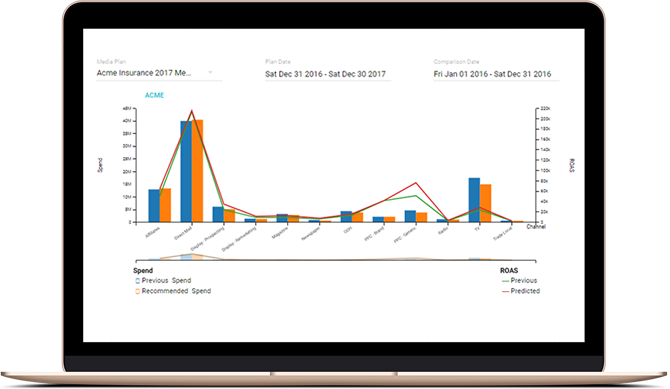Contents
- Why Marketing Mix Modeling (MMM) is Still Valuable
- The Benefits of Marketing Mix Modeling:
- When to Use Marketing Mix Modeling
- Traditional MMM vs. Modern MMM
- Pitfalls of Traditional MMM
- Benefits of Modern Marketing Mix Modeling
- So, Should Brands Still Use Marketing Mix Modeling Today?
- Modern MMM is the Right Approach for Today… and Tomorrow
Is Marketing Mix Modeling Still Relevant?
07/15/2022
Marketing Mix Modeling has been around for decades, and it is one of the more common methods of marketing measurement. But because it has been around for quite some time, some marketers may question whether this method is still relevant today. Which begs the question… should brands still be using Marketing Mix Modeling?
The short answer: it depends! There is a difference between MMM solutions that are worth investing in and MMM solutions that aren’t. Luckily, OptiMine is here to break it all down for you in this blog post. Let’s dive in!
Why Marketing Mix Modeling (MMM) is Still Valuable

Marketing Mix Modeling, also known as Media Mix Modeling— or “MMM” for short— is a statistical method for building predictive models using multi-variate regression. The models evaluate media impressions and spend, non-marketing factors such as economic conditions or other elements that move business performance more broadly, and converting activity over-time to measure the contributions of each of these elements towards conversions (sales, traffic, customer acquisitions, engagement, branding impacts, etc.). These measures then allow the marketer to understand potential outcomes by evaluating different marketing investment levels or other scenarios.
Marketing Mix Modeling has been used by large brands for many decades and has historically been a means to understand how large traditional media campaigns (TV, Print, Radio) impact sales activity. MMM can be highly accurate and is a well-proven approach to marketing measurement.
The Benefits of Marketing Mix Modeling:
Time Series Modeling Approach
MMM uses a time series modeling approach to examine whether changes in media reach (impressions, GRPs, etc.) over time correlate with conversion changes. For a simple example, consider the case where a brand places a billboard next to the highway. The model can examine sales before the billboard and now whether sales have increased with the placement of the new billboard. If the brand takes the billboard down and sales drop accordingly, puts the billboard back up and sales increase again, the brand can be reasonably confident that the billboard is impacting sales positively— and incrementally. Marketing Mix Models work in the same way to see how the reach of advertising affects sales outcomes.
Accounts for Other Factors Besides Media
Well-designed Marketing Mix Models also account for other factors besides media. In this case, the brand may also try to account for other factors such as the weather, traffic patterns, promotions, seasonality, holidays and day-of-week effects before confidently concluding that the media (the billboard) is the reason for changes in sales versus these other factors that may be playing a part in sales changes over time.
Accurate
While this method is probabilistic in nature and does not attempt to match media consumption at individual customer levels using PII, it can provide a very accurate measure of the incremental contribution of marketing investments on many different types of outcomes.
Measures Both Digital & Traditional Media
Marketing Mix Modeling has a major advantage over other measurement approaches such as Multi-Touch Attribution in that it can measure both digital and traditional media as well as online and offline conversion outcomes.
100% Privacy-Safe
Because Marketing Mix Modeling doesn’t use PII, it is fully privacy-safe.
When to Use Marketing Mix Modeling
Marketing Mix Modeling is best used when a brand wants to understand and measure the incremental contributions of their marketing. Specifically, when the brand has a mix of digital and traditional marketing channels.
Additionally, when the brand has a mix of conversion points including both online and offline, this makes PII/ tracking-based measurement much more difficult and MMM is better suited to handle this complexity.
MMM is an ideal fit for a more complex media mix and can handle this kind of marketing complexity as well as help the brand get more performance/efficiency from their marketing budget.

Traditional MMM vs. Modern MMM
Before we move on, it is important to distinguish the difference between “Traditional MMM” and “Modern MMM”. Traditional Marketing Mix Modeling was designed many years ago and has become outdated, whereas Modern Marketing Mix Modeling has evolved to meet the marketing needs of today by using AI, high-speed computing and data science, becoming a highly effective contemporary solution (that solves the issues of Traditional MMM).
Pitfalls of Traditional MMM
Brands have been frustrated with the many shortcomings of Traditional MMM:
- Slow
- Expensive
- Inflexible
- Not actionable
- Shows dated data
Older solutions like Traditional Marketing Mix Modeling just don’t cut it in today’s cut-throat, constantly evolving marketing environment.
Benefits of Modern Marketing Mix Modeling
Modern MMM addresses the pitfalls of Traditional MMM, with improved capabilities that make it a very beneficial (and valuable) solution for brands. Modern MMM is:
Fast.

It is built to match the speed of today’s ultra-competitive market and matches the pace of a brand’s decisions. Traditional MMM is too slow, and brands continually complain that they get MMM results too late.
Agile.

Modern MMM is built for today’s complex data environment. This “data first” approach of Modern MMM allows brands to adapt quickly, evolve the question they pose to analytics, and adjust to the constantly changing data environment.
Delivers detailed, actionable guidance.

A common complaint of Traditional MMM is that the guidance is too summarized to be actionable. Results and reads at channel levels using data that is summarized by week or month doesn’t cut it anymore. Brands are under enormous financial pressures and detailed guidance delivers ROI and lift opportunities missed by Traditional MMM solutions that can’t produce campaign-level measures.
With the detailed guidance that Modern MMM delivers, brands can act immediately on the data provided.
So, Should Brands Still Use Marketing Mix Modeling Today?

Yes, Modern MMM. Traditional MMM is too outdated, expensive, and slow to meet today’s marketing measurement needs.
Modern MMM will set brands up for future success in the privacy-first world we now live in, because it is fully future-proof. Unlike identity-based measurement systems, Modern Marketing Mix Modeling is not powered by user-level data. Instead, Modern MMM uses aggregated data from a range of variables and channels to examine marketing effects without tracking users.
Modern MMM is the Right Approach for Today… and Tomorrow
Privacy regulations will continue to change, and Modern MMM provides a stable measurement tool unchanged by fluctuations in data availability, making this methodology the most resilient to privacy changes.
Solve today’s marketing measurement quandaries by using a proven modern approach to Marketing Mix Modeling. Contact OptiMine to learn more!
Additional resources:
- “5 Marketing Attribution Tips to Protect Your Business” Blog Post
- “Selecting a Marketing Attribution Tool” Blog Post
- “Marketing Attribution FAQ” Blog Post
- “What is Multi-Touch Attribution?” Blog Post
- “Attribution vs. Marketing Mix Modeling” Blog Post
- “Your Marketing Measurement is Going Dark” Blog Post
- “Multi-Touch Attribution is Dead” eBook
- “4 Ways to Future-Proof Your Marketing Measurement” eBook
- OptiMine On-Demand Webinar: “The Measurement Dilemma: Navigating Privacy Driven Disruption”
- OptiMine x TickPick On-Demand Presentation: “ARF Measurement Challenges Showcase”

